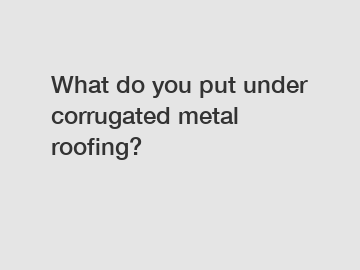What do you put under corrugated metal roofing?
What do you put under corrugated metal roofing?
Corrugated metal roofing is a durable and versatile option for protecting your home or business from the elements. Whether you are installing a new roof or replacing an old one, it is essential to ensure that the proper underlayment is used. The underlayment serves as an additional layer of protection and helps to prevent leaks, improve insulation, and increase energy efficiency. In this article, we will discuss the various options for what to put under corrugated metal roofing.
H2: Types of underlayment for corrugated metal roofing.

1. Synthetic Underlayment: .
Synthetic underlayment is a popular choice for corrugated metal roofing due to its durability and ease of installation. It is made from woven polyethylene or polypropylene materials and is designed to resist tears, leaks, and UV damage. Synthetic underlayment also offers excellent traction for workers during installation and is compatible with a wide range of roofing materials. It is an ideal choice for both residential and commercial roofing projects.
2. Felt Paper:
Felt paper, also known as roofing felt, is a traditional underlayment material that has been used for decades. It is made from cellulose or fiberglass mat coated with asphalt. Felt paper provides a protective barrier against moisture, condensation, and wind-driven rain. It is relatively inexpensive, easy to install, and compatible with most roofing systems. However, felt paper may not be as durable or long-lasting as synthetic underlayment.
3. Rubberized Asphalt:
Rubberized asphalt is a self-adhering underlayment that offers superior waterproofing and sealing properties. It is made from a blend of asphalt and synthetic rubber, providing excellent flexibility and resistance to extreme temperatures. Rubberized asphalt is ideal for areas prone to heavy rainfall or frequent storms. It creates a watertight barrier between the metal roofing and the roof deck, preventing water infiltration and potential damage.
4. Foam Insulation:
Foam insulation is often used in conjunction with other underlayment materials to enhance energy efficiency and insulation. It is available in rigid or spray foam form and offers excellent thermal resistance. Foam insulation helps to minimize heat transfer, reduce energy costs, and create a more comfortable living or working environment. However, foam insulation alone may not provide sufficient protection against moisture.
H2: Considerations for choosing the right underlayment.
1. Climate:
The climate in which you live plays a significant role in determining the type of underlayment to use. If you reside in an area with high rainfall or extreme temperature fluctuations, a more robust underlayment like rubberized asphalt or synthetic material may be a better choice.
2. Building Codes:
Always check local building codes and regulations before selecting an underlayment. Certain areas may have specific requirements for fire resistance, wind resistance, or energy efficiency. Compliance with these codes will ensure that your roof meets safety standards and withstands harsh conditions.
3. Budget:
Consider your budget when choosing an underlayment. While synthetic underlayment and rubberized asphalt may offer superior durability and performance, they may also be more expensive. Felt paper, on the other hand, is a more affordable option but may require more frequent replacement.
In conclusion, choosing the right underlayment for corrugated metal roofing is crucial for its long-term performance and protection. Synthetic underlayment, felt paper, rubberized asphalt, and foam insulation are all viable options depending on your specific needs and budget. Always consult with a professional roofing contractor to determine the most suitable underlayment for your project.
For expert advice on underlayment options and installation, contact us today.
Contact us to discuss your requirements of galvanized corrugated steel sheets, coated steel plate product, painted steel coils. Our experienced sales team can help you identify the options that best suit your needs.

Comments
0